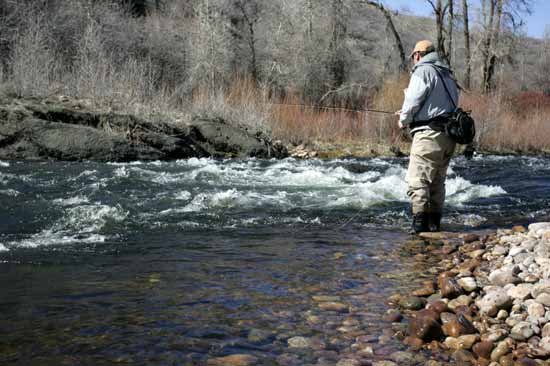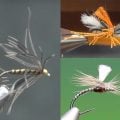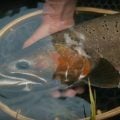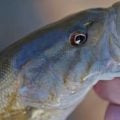Strike Indicators
MANY OF US are drawn to spring creeks and tailwaters because these rich environments produce heavy hatches of aquatic insects and offer the angler consistent and predictable dry fly fishing. On the other hand, the spring creek angler encounters periods—in almost any given day of fishing and especially over the course of a full season—when there is no surface activity at all. The dry fly purist may choose to fish with terrestrial patterns or attractors, but presenting nymphs in a dead drift manner is the most reliable fishing method during these periods. For most anglers, this nymph fishing involves a strike indicator. Since I work both as a guide and a fly shop employee, I am often asked about the best ways to rig indicators for spring creek fishing. Here are some thoughts that may help you choose the best system for your own fishing.
Before discussing the specifics of indicator fishing, I should acknowledge that some anglers consider the use of any indicator to be repugnant, if not downright unethical. “It’s not really fly fishing”, they say, or “I might as well fish with a worm and a bobber.” Because of the use of (mostly) traditional tackle, fly fishing involves a set of self-imposed handicaps that we embrace as part of the sport. Although modern sinking lines allow us to fish deeper water than ever, a flyfisher will never be as efficient in deep water as a troller with a downrigger or a spin fisherman armed with several hundred yards of monofilament, a baited hook, and a heavy bell sinker. A good fly caster can handle plenty of wind, but not as well as a good baitcaster throwing a big spoon or leadhead jig. In many ways, the “inefficiency” of fly fishing is its defining characteristic.
Even among the fly fishing community, the sport is defined variously. Some anglers fish choose to fish nothing but dry flies, others refuse to fish a sinking line, and still others fish weighted flies but turn their noses up at split shot on a leader. What we need to recognize is that these definitions carve up the sport along arbitrary lines, and that one angler’s vision of fly fishing is not morally superior to another.
What is a strike indicator? A strike indicator is anything that can be attached to the leader to let the waiting angler know that the drift of a sunken fly (or nearly invisible small dry fly) has been intercepted by a feeding fish. Therefore, the defining characteristics of an indicator are that it should float and it should be visible to the angler.
When explaining indicator systems to guide clients or shop customers, there are several nearly universal questions.
1. Do indicators spook fish? Absolutely. But for most anglers, the tradeoff in using an indicator is a positive one—for every fish scared away by the splash or shadow of an indicator, several are hooked by detecting strikes more quickly than could be done without the indicator.
2. How far from the fly should the indicator be? As with most important questions, the real answer is that it all depends. In this case, it depends on the depth of the water being fished and speed of the current. Even in an idealized situation (in which the fly would hang straight down from the indicator), the fly needs to be at least as far from the indicator as you wish the fly to be from the surface of the water. In the real world, the angler must increase this distance to allow for turbulence and slack in the leader. I usually recommend the indicator and fly to be separated one and a half to two times the depth being fished.
3. If adding split shot or other weight to the leader, how far from the fly should it be placed? I prefer to minimize added weight, so I put the shot as close to the fly as possible
Beyond these basic considerations comes the question of what kind of indicator to use. Some of the most popular and convenient — “bobber-type” indicators — come in all shapes and sizes. The other popular types include:
- Yarn
- Dry fly
- Greased leader
I’ll discuss each type of indicator and their use below.
“Bobber” Indicators
The effectiveness of fishing with an indicator has spawned a myriad of commercial indicators. Some of the most popular are the styles scorned by some as “bobbers”—manufactured of cork, plastic or foam, they float high enough to suspend a sizable weighted nymph, and since they are made or painted with fluorescent materials, they are easy to see, even in fast, choppy water.
Incidentally, these indicators are usually available in several colors: red or orange, chartreuse or yellow, and sometimes white. As a general rule, the red or orange shades are more visible in bright conditions, and chartreuse or yellow is more visible in low light, as on overcast days or at dusk. Although it is not as garish, I find white to be difficult to see, as it blends in with foam and bubbles and light reflections on the water. (In Montana, when the cottonwood trees drop their seed fluff on the water, white indicators are an angler’s nightmare.)
Many of these styles can also be moved up and down the leader, an advantage for the angler who is fishing varying depths in the course of a day on the water. One factor to remember if the indicator is moved up and down the leader is that smaller tippet diameters sink more quickly than larger ones—if the angler puts a big Corkie at the junction of the fly line and leader butt, it will take a considerable amount of weight on the leader to pull the body of the leader down into deep, fast water. In my own fishing, I prefer to have “nothing but tippet” under the indicator. By using a level piece of material between the indicator and fly (of the diameter dictated by fly size and water type), I get the fastest possible sink rate with the minimum amount of added weight.
Because of their high buoyancy and visibility, these “bobber” style indicators are the most popular for fishing fast freestone streams, but they can become a liability when fishing the smoother currents of spring creeks and tailwaters. Most are oversized for these water types, and create too much shadow, both during casting and during the drift. Many of these indicators are manufactured in irregular shapes, and these shapes can be difficult to cast with any accuracy, a particular problem on spring creeks and tailwaters where the fish hold in very narrow feeding lanes. The irregular shapes also tend to catch fine tippet as the casting loop unrolls, resulting in a tangled leader. Finally, the larger indicators also land with enough splash to spook fish from considerable distances.
One style of foam indicator that is popular for spring creek nymph fishing is the “roll-on” adhesive foam tape. This type of indicator works fairly well because it sidesteps the problems noted above. These indicators are pre-cut in fairly small sizes, and they can be trimmed down to even smaller sizes with scissors. Also, unlike the “pinch-on” style foam tape, these indicators form a reasonably aerodynamic shape on the leader and will allow accurate casting. They still have their problems—the color rubs off the foam too easily and the adhesive doesn’t stick that well (until you try to get it off the leader when you remove the indcator)—but this is probably the best choice among these types of indicators for spring creek fishing.
Yarn Indicators
Yarn is one of the most versatile and popular materials for strike indicators. Although it requires some rigging to attach it to the leader, it is one of the best systems for spring creek fishing. The size of the indicator (i. e., the amount of yarn used) can be varied according to water type and the size of fly and amount of added weight being used. Yarn also lands softly and floats well.
The best yarn for indicators is fairly coarse in texture, and macramé yarn—if you can find it in appropriate colors—works very well. Finely textured yarns (such as Glo-bug yarn) will work, but capillary action draws water into the yarn more quickly and makes it more difficult to redry the indicator once it is waterlogged. I usually dress the yarn with a paste floatant when it first goes on the leader, and the new powder dryer/floatants work incredibly well for refloating the indicator.
On slow moving currents, I try to keep the indicator as small as possible while keeping it visible and buoyant enough to float the nymph attached to the tippet. Even though I am hesitant to give the trout brain more credit than it deserves, I am convinced that the presence of a large, bright indicator will put a fish down, especially if a number of drifts are needed to get the fly in exactly the right current line. My favorite color of yarn indicator is pale yellow—I find this color to be easy enough to pick out on the water, yet not so bright that I worry I will spook the fish with my tackle. However, don’t be afraid to use more material or a brighter color if necessary. A sixty-five year old angler and his twenty-five year old companion may find they need different sizes or colors of indicators to be successful. If you can’t see the indicator, there is no reason to use it.
Dry Fly Indicators
Although it is probably the most traditional style of strike indicator (see chapter 4 of Ray Bergman’s Trout, published in 1938), the use of a dry fly as an indicator has become very popular in the last decade. As long as the dry fly is visible and bouyant enough to function properly, this approach has several advantages. Even if the fish does not take the dry fly, there is little chance that it will spook the fish. This also gives the angler the opportunity to catch a fish on the indicator. Supposedly sophisticated spring creek trout will attempt to eat the indicator—even those ugly fluorescent ones—with surprising regularity. Using a dry fly as the indicator will allow some of these fish to be caught, not just cursed at.
There are a number of ways to rig both yarn and dry fly indicators. In the next issue’s column, I will describe a number of ways to set up these systems.
Greased Leader and Sight Fishing
One minimal “indicator” that can be useful in certain situations is to dress the leader with a paste floatant (thick silicone pastes work best), and watch the leader itself to detect a strike. While this removes the bulk of an added indicator from the leader — allowing better accuracy and a more subtle presentation of the fly — it also offers much less buoyancy and is much harder to see. It is useful for presenting a midge larva or pupa pattern on very slow currents or stillwater, especially in flat light. In these light conditions, other indicators can be very difficult to see, but the greased leader shows up as a dark line on the surface film of the water. However, in faster currents or even the slightest breeze, this approach does not provide enough flotation to work.
In the right conditions, one of the most effective (and certainly among the most interesting) nymph fishing techniques is to remove the indicator entirely and detect strikes by watching the fish react to the fly. Like the greased leader technique, the absence of any bulk on the leader allows for more accurate casting and creates less commotion when the fly is presented.
There are several critical ingredients in this technique. One is that the fish must be visible, so good spotting light is essential. The angler must also be able to mark the fly as it hits the water to make sure the fly is presented in the same current line as the fish. It is also important to be able to judge the sink rate of the fly, as the fly needs to be presented far enough upstream of the fish to get the fly to the fish’s level.
If these prerequisites are met, the angler makes the cast and then follows the fly’s progress at the speed of the current until it nears the fish. At that point, the angler’s eyes shift their focus to the fish and watch for a reaction. If the fly is in exactly the right feeding lane, the fish may just open and close its mouth. The interior of the fish’s mouth sometimes appears as a flash of lighter color, which is why some anglers refer to this technique as “white mouthing” the fish. Often, the fish will move slightly from side to side to intercept the nymph, and the angler can judge from the fish’s body language when the fly has been taken. Look for the fish to make a sudden stop as it intercepts the nymph, sucks it in, and turns back to its original lie. Quick reactions are essential—as soon as it detects that the fly is not food, the fish will try to eject the fly from its mouth. Even if the angler’s reaction time is slow, sharp hooks will also help—if you see the fish suddenly start to shake its head back and forth, it is probably trying to get rid of a sticky sharp hook.
Sight fishing requires decent vision, the right light conditions, and a fair amount of practice. However, like most subtle angling techniques, it can be a deadly way to catch fish, and a whole lot of fun.












